Apgar score of less than 7 at 5 minutes for birth at or after term
Apgar scores are clinical indicators of a baby’s condition shortly after birth, with a score of less than 7 indicating potential complications for the baby. For more information, see Clinical commentary.
This indicator examines those liveborn babies with an Apgar score of less than 7 at 5 minutes for births at or after term (37 weeks of gestation or more).
Key findings
In 2021, 1.3% of liveborn babies born at or after term had an Apgar score of less than 7 at 5 minutes.
The proportion of liveborn babies born at or after term with an Apgar score of less than 7 at 5 minutes:
- has increased slightly from 0.9% in 2004 to 1.3% in 2021, but has remained relatively stable since 2013
- was highest in babies born to mothers aged younger than 20 (2.3% in 2021) compared with other age groups
- was higher for babies born in public hospitals (1.5%) than in private hospitals (0.8%) in 2021.
The interactive data visualisation (Figure 13) presents data for live births at or after term with an Apgar score of less than 7 at 5 minutes by selected maternal characteristics. Select the trend button to see how data have changed between 2004 and 2021.
Figure 13: Apgar score of less than 7 at 5 minutes for births at or after term
Apgar score of less than 7 at 5 minutes for births at or after term, 2004 to 2021.
This chart shows the proportion of babies with an Apgar score of less than 7 at 5 minutes for births at or after term, for the current data 2021 and trend data from 2004 to 2021. The proportion of babies with an Apgar score of less than 7 at 5 minutes for births at or after term, for all Australia showed a gradually increasing trend from 0.9% in 2004, peaking at 1.4% in 2016, with rates stabilising at 1.3% in all years since then.

Clinical commentary
An Apgar score is based on five characteristics of the baby: skin colour, pulse, breathing, muscle tone and reflex irritability. Each characteristic is given between 0 and 2 points, with a total score between 0 and 10 points. An Apgar score of 7 or more at 5 minutes after birth indicates the baby is adapting well to the environment, while a score of less than 7 indicates an increased risk of complications for the baby (AIHW 2023).
Apgar scores at 5 minutes of less than 7 are not specific to any condition and may reflect congenital anomaly, prematurity, perinatal infection, effects of drugs given to the mother for pain relief or anaesthesia, ineffective resuscitation or prolonged hypoxia before birth (Li et al. 2013). Babies with an Apgar score of less than 7 at 5 minutes have an increased likelihood of requiring resuscitation and admission to the special care nursery or neonatal intensive care unit. Low birthweight babies, pre-term babies and babies with a breech presentation accounted for a higher proportion of all liveborn babies born with Apgar scores less than 7 in 2021 (AIHW 2023). Maternal factors such as increased maternal age, obesity, maternal morbidity, especially diabetes, and maternal smoking during pregnancy, may contribute to a baby being born with a low Apgar score (Kharkova et al. 2017; Straube et al. 2010; Zhu et al. 2015).
Indicator specifications and data
Excel source data tables are available from Data.
For more information refer to Specifications and notes for analysis in the technical notes.
AIHW (Australian Institute of Health and Welfare) (2023) Australia’s mothers and babies, AIHW, Australian Government, accessed 29 June 2023.
Kharkova O, Grjibovski A, Krettek A, Nieboer E and Odland J (2017) ‘Effect of smoking behaviour before and during pregnancy on selected birth outcomes among singleton full-term pregnancy: A Murmask country birth registry study’, International Journal of Environmental Research and Public Health, 14(8):867, doi:10.3390/ijerph14080867.
Li F, Wu T, Lei X, Zhang H, Mao M and Zhang J (2013) ‘The Apgar score and infant mortality’, PLOS One, 8(7):e69072, doi:10.1371/journal.pone.0069072.
Straube S, Voigt M, Jorch G, Hallier E, Briese V and Borchardt U (2010) ‘Investigation of the association of Apgar score with maternal socio-economics and biological factors: an analysis of German perinatal statistics’, Archives of Gynaecology and Obstetrics, 282(2):135–141, doi:10.1007/s00404-009-1217-7.
Zhu T, Tang J, Zhao F, Qu Y and Mu D (2015) ‘Association between maternal obesity and offspring Apgar score or cord pH: a systematic review and meta-analysis’, Scientific Reports, 5:18386, doi:10.1038/srep18386.


